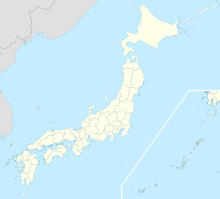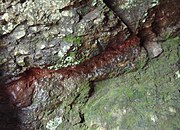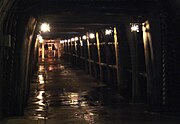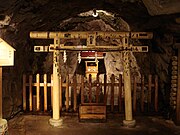History
The Minister of Gold Mines Okubo was put in charge of exploiting Toi.
Mining at Toi gold mine in the 17th century.
Small-scale gold mining is said to have started at Toi around 1370 during the period of the Ashikaga shogunate. [1] The gold mine was operated on a large scale from the time of Tokugawa Ieyasu in the late 16th century. [2] Several mines were open in 1577, but Tokugawa Ieyasu expanded production from 1601. [1] He put the exploitation of the mine under the responsibility of a Kinzan Bugyō selected from the Ōkubo clan.
Toi was one of around 60 goldmines located in the Izu Peninsula, including Yugashima and Nawaji. [2] [1] The gold and silver produced by these mines permitted the production of Tokugawa coinage, and allowed for the prosperity of the Tokugawa. The village of Toi itself became highly prosperous, with numerous trades flooding in to service the workers and the administration at the gold mine, so that Toi became known as "Toi Sengen" (土肥千軒, "Toi of the 1,000 shops"). [1]
The mine became less productive as it became flooded. [2] Workers were killed because of the exhausting conditions due to seeping hot springs and poor oxygen content of air, leading to the installation of water pumps and ventilators at numerous intervals. [3]
In 1917, gold was again discovered at the mine, and exploitation continued under the company Toi Kinzan KK. In 1931, the mine entered Sumitomo Group, and passed under Toi Kōgyō KK in 1942. The mine was ultimately closed in 1965 and then reopened for tourism. [3]

Ōda is a city in Shimane Prefecture, Japan. The city has a total area of 436.11 km2. As of 1 December 2022, the city had an estimated population of 32,838 in 15557 households and a population density of 75 persons per km2. The total area of the city is 435.71 square kilometres (168.23 sq mi). Ōda is home to the Iwami Ginzan Silver Mine, a World Heritage Site.

Sado Province was a province of Japan until 1871; since then, it has been a part of Niigata Prefecture. It was sometimes called Sashū (佐州) or Toshū (渡州). It lies on the eponymous Sado Island, off the coast of Niigata Prefecture.

Sado is a city located on Sado Island in Niigata Prefecture, Japan. Since 2004, the city has comprised the entire island, although not all of its total area is urbanized. Sado is the sixth largest island of Japan in area following the four main islands and Okinawa Island. As of June 1, 2023, the city has an estimated population of 48,195 and a population density of 56.3 inhabitants per square kilometre (146/sq mi). The total area is 855.69 square kilometres (330.38 sq mi).

Sado Island is an island located in the eastern part of the Sea of Japan, under the jurisdiction of Sado City, Niigata Prefecture, Japan, with a coastline of 262.7 kilometres (163.2 mi). In October 2017, Sado Island had a population of 55,212 people. Sado Island covers an area of 854.76 km2 (330.02 sq mi), and is the second largest island after Okinawa Island outside of the four main islands of Japan, excluding the disputed Southern Kurils. The shortest distance between Sado Island and Honshu is 32 km (20 mi). The highest peak on Sado Island is Mount Kinpoku, with an elevation of 1,172 m (3,845 ft).

Zōjō-ji (増上寺) is a Jōdo-shū Buddhist temple in Tokyo, Japan. It is the main temple of the Jōdo-shū Chinzei sect of Buddhism in the Kantō region,. Its mountain name is San'en-zan (三縁山).

Toi is a town located in Tagata District, Shizuoka Prefecture, Japan on the west coast of Izu Peninsula facing Suruga Bay.

Izu is a city located in central Izu Peninsula in Shizuoka Prefecture, Japan. As of 1 April 2019, the city had an estimated population of 30,678 in 13,390 households, and a population density of 84 persons per km2. The total area of the city was 363.97 square kilometres (140.53 sq mi).

Mining in Japan is minimal because Japan does not possess many on-shore mineral resources. Many of the on-shore minerals have already been mined to the point that it has become less expensive to import minerals. There are small deposits of coal, oil, iron and minerals in the Japanese archipelago. Japan is scarce in critical natural resources and has been heavily dependent on imported energy and raw materials. There are major deep sea mineral resources in the seabed of Japan. This is not mined yet due to technological obstacles for deep sea mining.

Shizuoka Sengen Jinja (静岡浅間神社) is the name for a collective group of three Shinto shrines now forming a single religious corporation, located at Mount Shizuhata in Aoi-ku, Shizuoka, in Shizuoka Prefecture, Japan. These shrines are the Kanbe Jinja (神部神社), Sengen Jinja (浅間神社), and Ōtoshimioya Jinja (大歳御祖神社). The main festival of the shrine is held annually on April 5.
Japanese currency has a history covering the period from the 8th century AD to the present. After the traditional usage of rice as a currency medium, Japan adopted currency systems and designs from China before developing a separate system of its own.

The Ōgon Shrine also known as the Jinguashi Shinto Shrine, Gold Temple or Spirits of the Mountain Shrine is a Shinto shrine located halfway up a mountain in the Gold Ecological Park in Jinguashi, Ruifang District, New Taipei City, Taiwan.

Sado bugyō (佐渡奉行) were officials of the Tokugawa shogunate responsible for administration of the mining operations at Sado.

Aikawa was a town located in Sado Island, Niigata Prefecture, Japan.

Myōhōkekyōzan Ankokuron-ji (妙法華経山安国論寺) is a Buddhist temple of the Nichiren sect in Kamakura, Kanagawa, Japan. It is one of a group of three built near the site in Matsubagayatsu (Valley of Pine Needles where Nichiren, founder of the Buddhist sect that bears his name, is supposed to have had his hut.
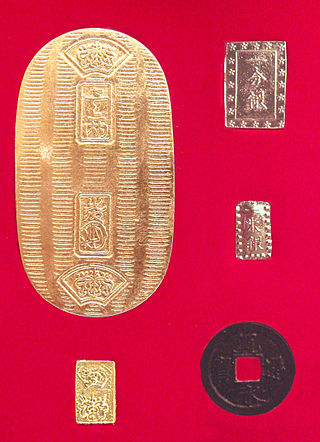
Tokugawa coinage was a unitary and independent metallic monetary system established by shōgun Tokugawa Ieyasu in 1601 in Japan, and which lasted throughout the Tokugawa period until its end in 1867.

The Toi Gold Museum is a museum on the subject of gold mining in ancient and modern Japan, which is located next to the Toi gold mine in the city of Izu, Shizuoka, Japan.
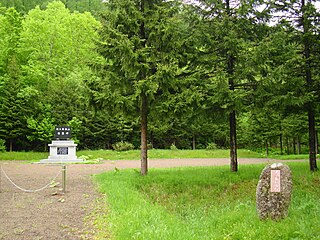
The Konomai Mines are located 30 km south of Monbetsu, Abashiri Subprefecture, Hokkaidō, Japan . The discovery was made in 1915. From then until 1973 when the mine was closed, 73 tons of gold and 1200 tons of silver were produced by the Sumitomo group.

The Sado gold mine is a generic term for gold and silver mines which were once located on the island of Sado in Niigata Prefecture, Japan. Among these mines, the Aikawa Gold and Silver Mine was the largest and was in operation until the modern era. The Sado Gold and Silver Mine was inscribed on Japan's World Heritage Tentative List under the title "The Sado Complex of Heritage Mines, Primarily Gold Mines" in 2010.

The Kurokawa gold mine was a gold mine located in the city of Kōshū, Yamanashi, Japan which was in operation for several hundred years from the Sengoku period into the modern era. The site, along with the Nakayama gold mine was collectively designated a National Historic Site of Japan in 1997 as the Kai gold mine sites.


